


8 months ago
A photorealistic selfie-style image of Ciri 30 years old woman with glowing skin, long wavy hair, and a curvaceous figure, taken directly through her phone’s camera. She is sitting on the edge of a luxurious bed, wearing a loosely tied silk robe that reveals her exposed torso and thin underwear, emphasizing her large, very full chest, slim waist, and rounded hips. She holds the phone in one hand, smiling confidently, with her face and upper body clearly visible in the frame. The background is softly blurred, showing a plush bed, fur throw blanket, and warm golden lighting, with a realistic reflection of her phone screen glow on her face. Ultra-detailed textures, natural lighting, and high-definition realism rendered in 4K resolution.

7 months ago
A photorealistic selfie-style image of a stunning 21-year-old woman with glowing skin, long wavy hair, and a curvaceous figure, taken directly through her phone’s camera. She is sitting on the edge of a luxurious bed, wearing a loosely tied silk robe that reveals a lace bralette and matching underwear, emphasizing her full chest, slim waist, and rounded hips. She holds the phone in one hand, smiling confidently, with her face and upper body clearly visible in the frame. The background is softly blurred, showing a plush bed, fur throw blanket, and warm golden lighting, with a realistic reflection of her phone screen glow on her face. Ultra-detailed textures, natural lighting, and high-definition realism rendered in 4K resolution.

8 months ago
A photorealistic selfie-style image of a stunning 21-year-old woman with glowing skin, long wavy hair, and a curvaceous figure, taken directly through her phone’s camera. She is sitting on the edge of a luxurious bed, wearing a loosely tied silk robe that reveals a lace bralette and matching underwear, emphasizing her full chest, slim waist, and rounded hips. She holds the phone in one hand, smiling confidently, with her face and upper body clearly visible in the frame. The background is softly blurred, showing a plush bed, fur throw blanket, and warm golden lighting, with a realistic reflection of her phone screen glow on her face. Ultra-detailed textures, natural lighting, and high-definition realism rendered in 4K resolution.

8 months ago
A photorealistic selfie-style image of a stunning 21-year-old light-skinned Black woman with glowing skin, long wavy hair, and a curvaceous figure, taken directly through her phone’s camera. She is sitting on the edge of a luxurious bed, wearing a loosely tied silk robe that reveals a lace bralette and matching underwear, emphasizing her full chest, slim waist, and rounded hips. She holds the phone in one hand, smiling confidently, with her face and upper body clearly visible in the frame. The background is softly blurred, showing a plush bed, fur throw blanket, and warm golden lighting, with a realistic reflection of her phone screen glow on her face. Ultra-detailed textures, natural lighting, and high-definition realism rendered in 4K resolution.

4 months ago
A photorealistic selfie-style image of a stunning 21-year-old woman with glowing skin, long wavy hair, and a curvaceous figure, taken directly through her phone’s camera. She is sitting on the edge of a luxurious bed, wearing a loosely tied silk robe that reveals her exposed, uncovered torso and thin underwear, emphasizing her large, very full chest, slim waist, and rounded hips. She holds the phone in one hand, smiling confidently, with her face and upper body clearly visible in the frame. The background is softly blurred, showing a plush bed, fur throw blanket, and warm golden lighting, with a realistic reflection of her phone screen glow on her face. Ultra-detailed textures, natural lighting, and high-definition realism rendered in 4K resolution.
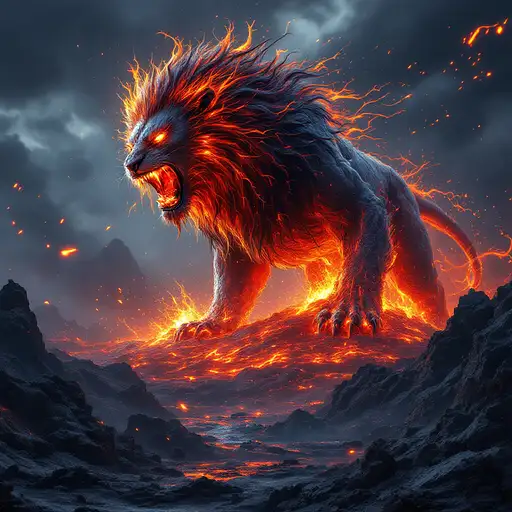
6 months ago
Volcano+Lion full body fusion, facing front and roaring , lava body, (((High Definition, 32K, Ultra High Resolution, Sharp Details))) detailed matte painting, deep color, fantastical, intricate detail, splash screen, complementary colors, fantasy concept art, 8k resolution trending on Artstation Unreal Engine 5

6 months ago
A photorealistic selfie-style image of a stunning 21-year-old woman with glowing skin, long wavy hair, and a curvaceous figure, taken directly through her phone’s camera. She is sitting on the edge of a luxurious bed, wearing a loosely tied silk robe that reveals a lace bralette and matching underwear, emphasizing her full chest, slim waist, and rounded hips. She holds the phone in one hand, smiling confidently, with her face and upper body clearly visible in the frame. The background is softly blurred, showing a plush bed, fur throw blanket, and warm golden lighting, with a realistic reflection of her phone screen glow on her face. Ultra-detailed textures, natural lighting, and high-definition realism rendered in 4K resolution.

4 months ago
Masterpiece, best quality, ultra-detailed, hyperrealistic, 8K, RAW photo, 35mm lens, f/1.2, cinematic lighting, soft backlight. The scene captures a joyful and confident moment where a woman is taking a selfie. She stands in a stylish, modern bedroom with soft natural light coming through large windows, casting a warm, intimate glow around her. A fit, very pale, blonde woman with long hair in a loose braid is holding her phone up to capture the perfect selfie. She is smiling and looking at the phone's camera with a confident, playful expression. Her full figure is visible in the selfie, from head to toe, showing the fitted blouse tucked into a high-waisted pencil skirt, which highlights her curves. The blouse has a subtle V-neck, slightly rolled-up sleeves, and gives off a relaxed yet polished vibe. The pencil skirt hugs her waist and hips, showcasing her natural silhouette. The final selfie captured on the phone's screen is visible, showing her entire body, capturing both the smile and the elegance of her outfit. Her makeup is soft with glowing skin and natural lip gloss, enhancing her radiant expression. The lighting focuses on the fluidity of her figure, with soft shadows accentuating her curves. The background is a clean, minimalist bedroom, with light textures and neutral tones that add to the fresh and elegant atmosphere.

25 days ago
A photorealistic selfie-style image of a stunning 30 year-old woman gorgeous Caucasian woman with striking almond shaped green eyes really long ginger wavy hair with dark blue and blond Stripes with long lush, thick lashes glossy lips with freckles, tattoos, piercings wearing a full face of makeup, with thick natural thighs, a small Lilly tattoo on her chest wearing a silver Connor necklace and a silver band with a beautiful white diamond ring on her wedding fingerwith glowing skin, long wavy hair, and a curvaceous figure, taken directly through her phone’s camera. She is sitting on the edge of a luxurious bed, wearing a loosely tied silk robe that reveals a lace bralette and matching underwear, emphasizing her full chest, slim waist, and rounded hips. She holds the phone in one hand, smiling confidently, with her face and upper body clearly visible in the frame. The background is softly blurred, showing a plush bed, fur throw blanket, and warm golden lighting, with a realistic reflection of her phone screen glow on her face. Ultra-detailed textures, natural lighting, and high-definition realism rendered in 4K resolution.

4 months ago
Create a meticulously staged cinematic scene with rigid symmetry and frontal, low-angle framing, emphasizing a diagonal composition (45-degree tilt) where all elements align along a single dynamic axis. Color Grading: 60% Dominant: Soft, powdery pastel pinks (Pantone 12-1109 TPX "Marshmallow") saturating the sky, snow, and TV casing. 30% Secondary: Frosted teal blues (HEX #6ECEDA) in the glacial lake, aurora, and TV screen static. 10% Accent: Mustard-yellow (Pantone 15-0950 TPX "Golden Glow") in the aurora streaks, wool tufts, and corroded metal knobs. TV Design: A 1950s Bakelite TV (matte eggshell plastic with hairline cracks) tilted diagonally (top-left corner at 10 o’clock, bottom-right submerged at 4 o’clock). Crack: A jagged diagonal fissure (2cm wide) splits the screen from top-left to bottom-right, leaking viscous, neon-bright color bar pigment (RGB values: pink #FF9EB5, teal #5FDAC3, gold #FFD700) that pools into the water below. Materials: Body: Faux-weathered plastic with chipped edges revealing rusted steel underlayers. Details: Three rotary knobs (tarnished brass, 4cm diameter) labeled "VOL," "TUNE," "POWER." Cables: Braided wool cords (undyed cream yarn, 3cm thickness) coiled around the TV’s base, fraying at the ends. Screen Imagery: Static Overlay: A 1953 RCA-style color bar test pattern (8 vertical bands) glitching every 2 seconds, causing the teal and pink bars to "melt" downward into liquid the word "Imagen-4" glitches on the screen Underlying Image: A faint, glowing topographical map (golden-yellow lines on indigo) dissolves into water that cascades from the screen’s crack, merging with the glacial lake. Environment: Glacial Lake: Semi-frozen water (translucent teal, 70% opacity) with jagged ice shards (20cm height) encircling the TV. Snowfall: Heavy, dense snowflakes (1cm diameter) falling at 45 degrees, accumulating on the TV’s top-left corner. Aurora Borealis: Three parallel bands (pink #FFB3D1, teal #7FE5E5, gold #FFE44D) in smooth sine waves, 15° tilt, 80% opacity. Sky: Ultra-high-contrast starfield (ISO 51200 noise pattern) with 2,000 visible stars (randomized 2-4px white dots). Lighting & Effects: Key Light: A frontal, low-orange sodium vapor lamp (3200K) casting sharp diagonal shadows (20° angle) from the TV onto the ice. Bloom: Halation around the aurora and screen, radius 15px, intensity 70%. Textures: Film Grain: 35mm Kodak Vision3 250D overlay (gritty, high-detail). Lens Defects: Two hairline scratches (1px width) at 15° and 75° angles, plus hexagonal lens flare (60% opacity) from the aurora. Physics & Motion: Water: Viscous fluid dynamics—the leaking color bars swirl in 5cm eddies, blending with the glacial lake. Wool: Submerged yarn floats upward in 10cm tufts, swaying at 0.5Hz frequency. Result: A hyper-detailed, reference-free scene that implicitly channels Wes Anderson’s aesthetic through obsessive symmetry, retro-kitsch materials, and a strict 60/30/10 pastel hierarchy—no director named, all style embedded in granular technical specs.

4 months ago
"Create a meticulously staged cinematic scene with rigid symmetry and frontal, low-angle framing, emphasizing a diagonal composition (45-degree tilt) where all elements align along a single dynamic axis. Color Grading: 60% Dominant: Soft, powdery pastel pinks (Pantone 12-1109 TPX "Marshmallow") saturating the sky, snow, and TV casing. 30% Secondary: Frosted teal blues (HEX #6ECEDA) in the glacial lake, aurora, and TV screen static. 10% Accent: Mustard-yellow (Pantone 15-0950 TPX "Golden Glow") in the aurora streaks, wool tufts, and corroded metal knobs. TV Design: A 1950s Bakelite TV (matte eggshell plastic with hairline cracks) tilted diagonally (top-left corner at 10 o’clock, bottom-right submerged at 4 o’clock). Crack: A jagged diagonal fissure (2cm wide) splits the screen from top-left to bottom-right, leaking viscous, neon-bright color bar pigment (RGB values: pink #FF9EB5, teal #5FDAC3, gold #FFD700) that pools into the water below. Materials: Body: Faux-weathered plastic with chipped edges revealing rusted steel underlayers. Details: Three rotary knobs (tarnished brass, 4cm diameter) labeled "VOL," "TUNE," "POWER." Cables: Braided wool cords (undyed cream yarn, 3cm thickness) coiled around the TV’s base, fraying at the ends. Screen Imagery: Static Overlay: A 1953 RCA-style color bar test pattern (8 vertical bands) glitching every 2 seconds, causing the teal and pink bars to "melt" downward into liquid with the word "Prompthero" barely visible on it. Underlying Image: A faint, glowing topographical map (golden-yellow lines on indigo) dissolves into water that cascades from the screen’s crack, merging with the glacial lake. Environment: Glacial Lake: Semi-frozen water (translucent teal, 70% opacity) with jagged ice shards (20cm height) encircling the TV. Snowfall: Heavy, dense snowflakes (1cm diameter) falling at 45 degrees, accumulating on the TV’s top-left corner. Aurora Borealis: Three parallel bands (pink #FFB3D1, teal #7FE5E5, gold #FFE44D) in smooth sine waves, 15° tilt, 80% opacity. Sky: Ultra-high-contrast starfield (ISO 51200 noise pattern) with 2,000 visible stars (randomized 2-4px white dots). Lighting & Effects: Key Light: A frontal, low-orange sodium vapor lamp (3200K) casting sharp diagonal shadows (20° angle) from the TV onto the ice. Bloom: Halation around the aurora and screen, radius 15px, intensity 70%. Textures: Film Grain: 35mm Kodak Vision3 250D overlay (gritty, high-detail). Lens Defects: Two hairline scratches (1px width) at 15° and 75° angles, plus hexagonal lens flare (60% opacity) from the aurora. Physics & Motion: Water: Viscous fluid dynamics—the leaking color bars swirl in 5cm eddies, blending with the glacial lake. Wool: Submerged yarn floats upward in 10cm tufts, swaying at 0.5Hz frequency. Result: A hyper-detailed, reference-free scene that implicitly channels Wes Anderson’s aesthetic through obsessive symmetry, retro-kitsch materials, and a strict 60/30/10 pastel hierarchy—no director named, all style embedded in granular technical specs.

6 months ago
(Primary Subject: Woman, 3D-Printed in Realistic Modern Printer, 1.7 weight) — inside a dim, cluttered bedroom illuminated by the soft, flickering glow of LED strip lights and the rhythmic hum of a modern consumer-grade 3D printer, a surreal scene unfolds. A half-assembled woman is being slowly 3D-printed, layer by layer, inside the printer’s transparent enclosure—her form emerging from glowing PLA-like filament in smooth, hyper-detailed strokes (hyper-realistic printing detail, smooth skin texture, 1.6 weight). Her upper body—torso, arms, and part of her face—is almost complete, formed from semi-translucent material that glows faintly in the ambient light. Thin wisps of support scaffolding cling to her like cyber-organic scaffolds. Her lower half remains unformed, an unfinished spiral of molten filament still being printed as the nozzle moves with quiet precision (realistic filament printing, printer detail, suspended form, 1.5 weight). Seated nearby, a man in casual clothes sits cross-legged on the floor, bathed in warm, ambient screen light. He holds a crumpled instruction manual in one hand—clearly pulled from the open cardboard box lying beside him on the floor, its packaging marked with surreal branding: “SYNTH-CRAFT V2 | HOMEBODY EDITION” (instructional design realism, subtle surreal packaging, 1.4 weight). Loose tools, empty filament spools, soda cans, and old PC parts are scattered around the room, grounding the scene in everyday reality. Behind him, the room glows with scattered LED lighting in hues of electric blue, soft magenta, and warm amber, reflecting off his glasses and casting moody highlights onto the surrounding walls. Dust particles drift in the air, caught in the glow of the printer’s chamber, creating an eerie yet beautiful halo around the forming woman (cinematic atmosphere, volumetric light, dusty haze, 1.4 weight). Rendered with cinematic realism: soft film grain, subtle lens blur, realistic plastic sheen, and dramatic shallow depth-of-field—captured as if shot with a Leica Summilux lens. The entire image is grounded in the plausible, but steeped in a surreal undertone that suggests something far stranger is unfolding (photographic detail, cinematic framing, narrative tension, 1.3 weight). This is not just a print job—it’s manufactured intimacy, wrapped in plastic and instruction sheets.

5 months ago
full body view of A very beautiful minute blonde woman with braids, flowery dress that leaves the shoulders uncovered and a red sash as a belt, barefoot (((show the foot))) hold a long katana, sit in a campfire with a robot with a head made of a cathode ray tube television, which portrays a smiley face on the screen, a body made of scrap metal that plays a guitar and a German shepherd dog.
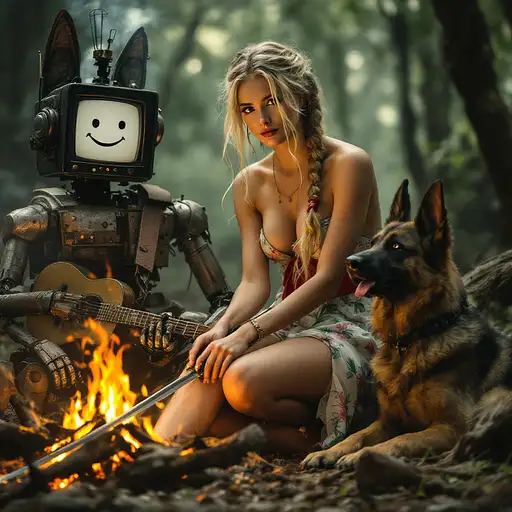
5 months ago
full body view of A very beautiful minute blonde woman with braids, flowery dress that leaves the shoulders uncovered and a red sash as a belt, barefoot (((show the foot))) hold a long katana, sit in a campfire with a robot with a head made of a cathode ray tube television, which portrays a smiley face on the screen, a body made of scrap metal that plays a guitar and a German shepherd dog.

2 months ago
((extremely muscular heavyweight bodybuilder)), perfectly handsome masculine face, strong jawline, symmetrical features, short black hair, glowing skin, highly detailed muscle definition, thick thighs larger than waist, shredded abs, wide chest, ultra photorealistic, 8K UHD, high-key lighting, vivid pastel tones, high brightness, high saturation, soft shadows, glowing skin, soft texture finish, natural smiling expression, emotionally connected, cozy indoor lighting, full-body expression, front-facing, camera at eye level, muscular physique taking up 50% of the screen, wearing tight jockstrap, hyper-detailed skin texture, masculine anatomy, soft diffused light, low contrast color grading, friendly and positive atmosphere, warm soft sunlight, clean skin, strong emotional connection, positive vibes, detailed background with high brightness and vibrant colors, full-body shot with vivid hues and high saturation, wearing a bright-colored tank top and tight workout shorts, located in a modern gym with weights in the background, mid-workout pose with arms raised in a flexing position, looking confident and powerful.

9 months ago
A chaotic and vivid depiction of an archangel’s desperate escape from hell (1.5), bursting through an endless sea of demons (1.4). The screen is filled with the writhing forms of countless grotesque creatures (1.6)—clawed hands (1.3) and twisted faces (1.3), their bodies an ocean of chaos and darkness (1.4) that stretches infinitely downward (1.3). Their fiery eyes glint with rage and desperation (1.5) as they claw upward, their blackened, smoky forms illuminated by the burning rivers of molten lava (1.4) coursing through the underworld. At the center of this chaos (1.4), the archangel appears small but unyielding (1.5)—a beacon of divine light (1.6) in a world consumed by fire and shadow. His radiant golden wings (1.5), tinged with hues of celestial blue (1.4) and fiery orange (1.4), struggle to break free of the mass of demons dragging him down (1.5). The light from his wings cuts through the smoky darkness (1.6) like shards of sunlight piercing a storm (1.3), creating a stark contrast to the hellish environment (1.4) around him. The angel’s form is dynamic (1.5), twisting mid-flight (1.4) as his powerful wings beat against the swarm (1.5). His robes, glowing faintly from within (1.4), are torn and tattered (1.3) from the ferocity of the battle. His hands grip a radiant celestial sword (1.5), its edge shimmering with divine fire (1.6), as he swings it downward (1.4), cutting through the demons clinging to his legs and arms (1.6). Streams of golden light trail behind the sword (1.5), slicing through the oppressive darkness (1.4). The demonic horde dominates the frame (1.6), their grotesque forms swirling and climbing over one another (1.4) in a desperate attempt to pull him back into the abyss (1.5). Clawed hands (1.4) reach upward, grasping at the angel’s robes, wings, and even his sword (1.5), while others are thrown back by the sheer force of his divine light (1.6). The demons’ smoky, ethereal bodies (1.5) dissolve and re-form (1.4), creating a sense of endless motion and chaos (1.6). The background is a hellish landscape (1.4), filled with erupting volcanoes (1.3), glowing rivers of lava (1.5), and jagged blackened rocks (1.3). The air is thick with smoke, ash, and embers (1.4), swirling in a fiery haze (1.5) that fills the scene with energy and tension. High above, faint traces of the heavens (1.4) are visible through the swirling chaos (1.3)—a glimmer of hope in the distance (1.5), beckoning the angel forward. The artistic style is inspired by Makoto Shinkai (1.6), with his signature ethereal lighting and emotional depth. Vibrant, dynamic lighting (1.5) contrasts the angel’s holy glow (1.6) with the fiery reds and blacks of the underworld (1.4). Rays of divine light pierce the chaos (1.5), creating an otherworldly palette of warm and cool tones (1.4) that evoke both awe and despair (1.5). The intricate details of the demons (1.4), the angel’s wings (1.5), and the molten landscape (1.3) add a sense of depth and movement, immersing the viewer in this epic struggle between good and evil (1.6).
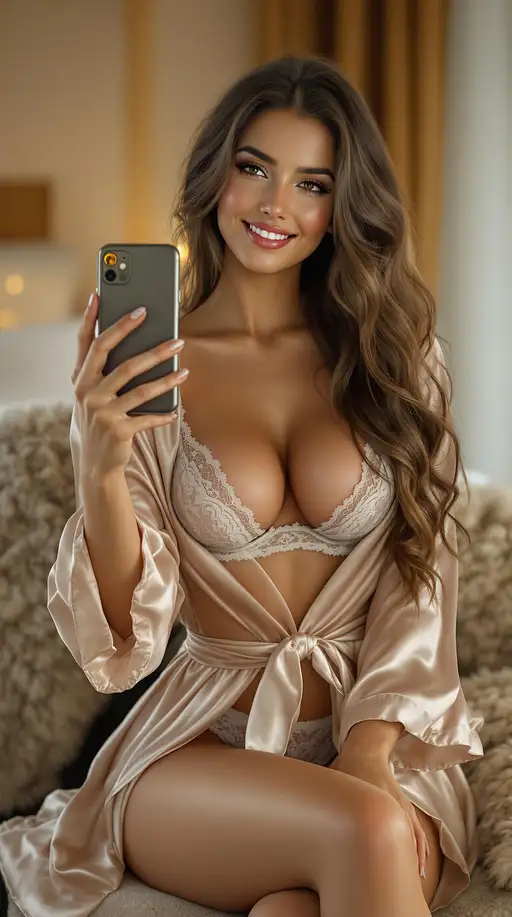
6 months ago
A photorealistic selfie-style image of a stunning 21-year-old woman with glowing skin, long wavy hair, and a curvaceous figure, taken directly through her phone’s camera. She is sitting on the edge of a chair, wearing a loosely tied silk robe that reveals a lace bralette and matching underwear, emphasizing her full chest, slim waist, and rounded hips. She holds the phone in one hand, smiling confidently, with her face and upper body clearly visible in the frame. The background is softly blurred, showing a plush bed, fur throw blanket, and warm golden lighting, with a realistic reflection of her phone screen glow on her face. Ultra-detailed textures, natural lighting, and high-definition realism rendered in 4K resolution.

29 days ago
A photorealistic selfie-style image of a stunning 30 year-old woman gorgeous Caucasian woman with striking almond shaped green eyes really long ginger wavy hair with dark blue and blond Stripes with long lush, thick lashes glossy lips with freckles, tattoos, piercings wearing a full face of makeup, with thick natural thighs, a small Lilly tattoo on her chest wearing a silver Connor necklace and a silver band with a beautiful white diamond ring on her wedding fingerwith glowing skin, long wavy hair, and a curvaceous figure, taken directly through her phone’s camera. She is sitting on the edge of a luxurious bed, wearing a loosely tied silk robe that reveals a lace bralette and matching underwear, emphasizing her full chest, slim waist, and rounded hips. She holds the phone in one hand, smiling confidently, with her face and upper body clearly visible in the frame. The background is softly blurred, showing a plush bed, fur throw blanket, and warm golden lighting, with a realistic reflection of her phone screen glow on her face. Ultra-detailed textures, natural lighting, and high-definition realism rendered in 4K resolution.
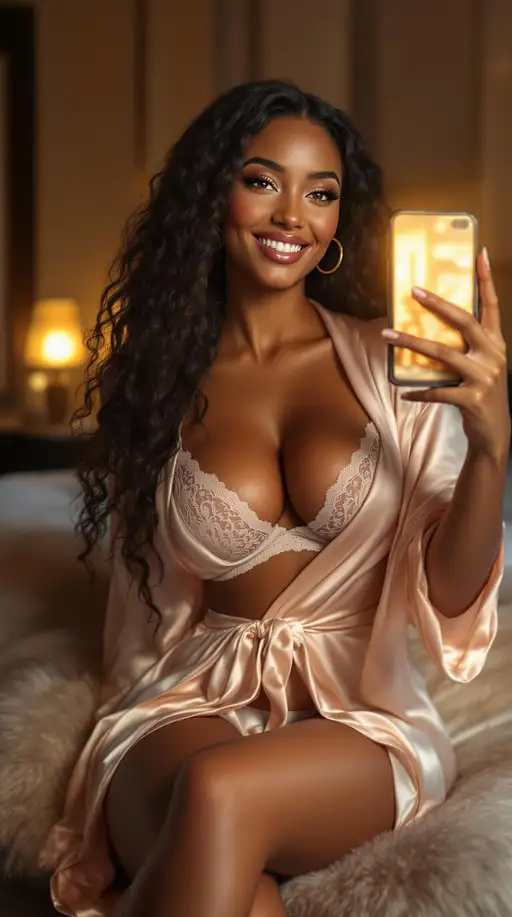
3 months ago
A photorealistic selfie-style image of a stunning 22-year-old Caribbean woman with tanned skin, long curly hair, and a curvaceous figure, taken directly through her phone’s camera. She is sitting on the edge of a luxurious bed, wearing a loosely tied silk robe that reveals a lace bralette and matching underwear, emphasizing her full chest, slim waist, and rounded hips. She holds the phone in one hand, smiling confidently, with her face and upper body clearly visible in the frame. The background is softly blurred, showing a plush bed, fur throw blanket, and warm golden lighting, with a realistic reflection of her phone screen glow on her face. Ultra-detailed textures, natural lighting, and high-definition realism rendered in 4K resolution.

8 months ago
A photorealistic selfie-style image of a stunning 21-year-old woman with glowing skin, long wavy hair, and a curvaceous figure, taken directly through her phone’s camera. She is sitting on the edge of a luxurious bed, wearing a loosely tied silk robe that reveals a lace bralette and matching underwear, emphasizing her full chest, slim waist, and rounded hips. She holds the phone in one hand, smiling confidently, with her face and upper body clearly visible in the frame. The background is softly blurred, showing a plush bed, fur throw blanket, and warm golden lighting, with a realistic reflection of her phone screen glow on her face. Ultra-detailed textures, natural lighting, and high-definition realism rendered in 4K resolution.

5 months ago
(Ultra-detailed digital art masterpiece, retro 90s aesthetic, inspired by Yoshiaki Kawajiri, Yutaka Minowa, Yūji Ikehata. Cinematic, intense detail, photorealistic, high contrast, gritty texture, chromatic aberration, melancholic and disturbing aesthetic. Shallow depth of field, volumetric lighting, perspective-heavy, reminiscent of a low-res 1980s movie screen where reality and magic blur.)The image depicts a fantasy scene with a female warrior standing confidently. She is dressed in silver armor, including a long, intricately designed sword she holds firmly in her right hand. Her long, blonde hair is styled in a braid, and she wears a white, flowing garment that reveals her upper body. The background features a dark, mystical setting with a large, detailed dragon's head emerging from the shadows, adding to the fantasy atmosphere. The overall composition is highly detailed, with a focus on the warrior's striking appearance and the intricate design of her armor and weaponry..Atmosphere & Style: Dark, melancholic, and surreal. A blend of anime, cyberpunk, and dystopian themes, with elements of old VHS aesthetics and Greg Rutkowski-inspired dynamic lighting. Dust particles float in the air, illuminated by dramatic backlighting. The composition is cinematic, with a slightly grainy, retro anime texture, as if extracted from a lost 90s OVA. Model: ReV Animated

6 months ago
beautiful face, real skin, real face, long beautiful hair, big chest, full body skydoll, cyberpunk 2077, Ghost in the Shell, Deus Ex, Blade Runner, Matrix, smoke, UHD, details, insane details, hyper detailed, micro details, 50mm, f/1.6, photography, intricate details, photo realistic, finely detailed outfit, octane render, Unreal Engine, by Weta Digital, by Wêtà FX, by WLOP, Cinematic, Color Grading, Editorial Photography, Photography, Photoshoot, Gamma, White Balance, Neon, Light, Dark, Light Mode, Dark Mode, High Contrast, 5D, 32k, Super-Resolution, Megapixel, ProPhoto RGB, Big, Spotlight, Frontlight, Halfrear Lighting, Backlight, Rim Lights, Rim Lighting, Artificial Lighting, Natural Lighting, Incandescent, Optical Fiber, Moody Lighting, Cinematic Lighting, Studio Lighting, Soft Lighting, Hard Lighting, volumetric Light, Volumetric Lighting, Volumetric, Contre-Jour, Rembrandt Lighting, Split Lighting, Beautiful Lighting, Accent Lighting, Global Illumination, Optics, Materiality, Ambient Occlusion, Glowing, Shadows, Rough, Shimmering, Ray Tracing Reflections, Lumen Reflections, Screen Space Reflections, Diffraction Grading, Chromatic Aberration, GB Displacement, Anti-Aliasing, FXAA, TXAA, RTX, SSAO, Shaders, OpenGL-Shaders, GLSL-Shaders, Post Processing, Post-Production, Cel Shading, Tone Mapping, CGI, VFX, SFX, insanely detailed and intricate, [...] --ar 2:3 --q 1
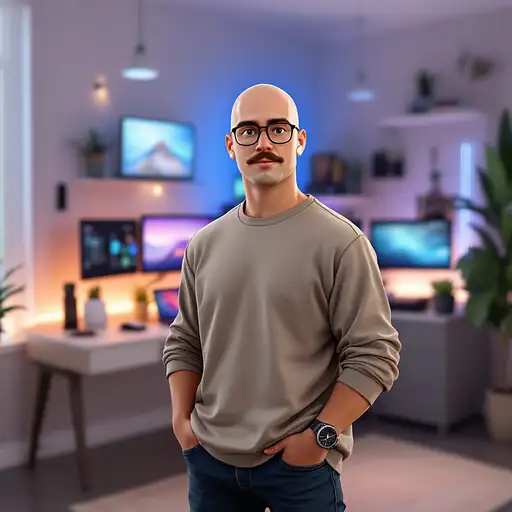
6 months ago
Create a semi-realistic male avatar with light skin, a large build, bald head (Buzz Cut hair), a mustache, and hazel eyes. The avatar is wearing stylish glasses, AirPods Pro, and a modern watch. Outfit is simple and casual. The background is a modern and youthful bedroom featuring a clean desk setup with multiple screens, a laptop, and ambient LED lights. Full body, Four-character views. front view, left side view, right side view, and back view)
